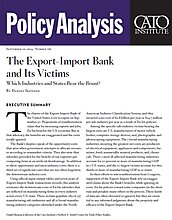The Bank’s skeptics speak of the opportunity costs that arise when government attempts to allocate resources according to nonmarket criteria. They also note that subsidies provided for the benefit of one exporter put competing firms at an artificial disadvantage. In addition to these opportunity and intra-industry costs, there is a third set of significant costs that are too often forgotten: the downstream industry cost.
Using official input-output tables and seven years of Export-Import Bank transactions records, this analysis estimates the downstream costs of Ex-Im subsidies that are inflicted on manufacturing firms in every industry across every U.S. state. These victims populate 189 of 237 manufacturing sub-industries and all 21 broad manufacturing industry categories identified under the North American Industry Classification System, and they incurred a net cost of $2.8 billion per year or $14.7 million per sub-industry per year as a result of Ex-Im policies.
Among the specific sub-industry victims bearing the largest costs are U.S. manufacturers of motor vehicle bodies; computer storage devices; and, photographic and photocopying equipment. The 5 broad manufacturing industries incurring the greatest net costs are producers of electrical equipment, appliances and components; furniture; food; nonmetallic mineral products; and, chemicals. These 5 most ill-affected manufacturing industries account for 50 percent or more of manufacturing GDP in 7 U.S. states, and the 10 largest victims account for two thirds or more of manufacturing GDP in 22 states.
In their efforts to win reauthorization from Congress, supporters of the Export-Import Bank rely on exaggerated claims about the Bank’s benefits, while ignoring its costs. Ex-Im policies reward some companies (in the short run) and penalize many others in the process. These kinds of data are often obscured or ignored, but they are essential to any informed judgments about the propriety and efficacy of the Export-Import Bank.

